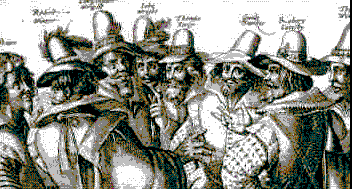 ) to set light to the fuse on the 5th November - the day the King was due to open Parliament!
) to set light to the fuse on the 5th November - the day the King was due to open Parliament!

Remember, remember, the fifth of November,
Gunpowder, treason and plot.
I see no reason why gunpowder treason,
Should ever be forgot!
Keywords: Guy Fawkes, King James I, Catholics
On the 5th November, 1605 there was an attempt by a small group of English traitors to blow up the Houses of Parliament using barrels of gunpowder hidden in a cellar underneath that building. We commemorate that event, and the fact that it failed, each year on the anniversary with a festival called Bonfire Night.
The plotters were trying not only to destroy the English government, but also to kill the king, King James I (who was also James VI of Scotland). The reasons for this went back over eighty years to King Henry VIII. In 1533, Henry had broken away from the Catholic church (the Church of Rome) and had made himself the Head of the Church in England. In effect, he had declared that he had no allegiance to the Pope in Rome, and declared that he was second only to God himself. In this way, the Church of England was created - the Protestant Church. Over the next eighty years or so, England had moved backwards and forwards between Protestantism (Henry, Edward VI and Elizabeth) and Catholicism (Queen Mary).
By the early seventeeth century, Catholics were in the minority as they had been oppressed savagely during most of Elizabeth's reign. When the Protestant James I (son of Mary Queen of Scots, the Catholic queen whom Elizabth had had beheaded) came to the throne, Catholics rejoiced and looked forward to being given more freedom to worship. James was believed to have pro-Catholic views. Before he had come to the throne, one of the people who later joined the Gunpowder Plot, Percy, had gone to visit him in Scotland, and James had led him to believe that he would improve the lot of Catholics in England.
However, James made no effort to improve life for Catholics living in England. Indeed, his parliament passed laws which made life even harder for Catholics, and when the king, whose signature was needed to make these laws official, willingly signed them, many Catholics in England became disillusioned with him. To be fair, James could hardly be seen to be supporting Catholics openly, as there was a great deal of fear and paranoia among the Protestant majority. People still remembered the massacre of thousands of Protestants in Paris about forty years before by hundreds of Catholics. Most people believed that the Catholics were plotting to rise up, destroy the Church of England, and commit bloody murder!

Unfortunately, one of the conspirators wrote an anonymous letter to one of the members of Parliament, Lord Monteagle, warning him not to attend on that day. It was originally believed that the leak came from the last conspirator to be recruited - the thirteenth - called Francis Tresham, who was Lod Monteagle's brother-in-law. The first thing that Lord Monteagle did was to inform the authorities, and an immediate investigation was launched. Indeed, Guy Fawkes was discovered by a group of soldiers standing guard over the gunpowder itself in the cellar. No-one knows who wrote the letter to Lord Monteagle - indeed, some historians believe that he may have written it himself, and simply pretended to have received it. After all, the plot hadn't been a very well kept secret!
Anyway, the secret was out now. Guy Fawkes was tortured (subjected to the rack and the thumbscrew) and eventually revealed the names of the other conspirators. Some of them were arrested immediately, but others escaped. The last conspirators were eventually cornered in a house in the Midlands and shot.
The conspirators that had been captured were tried, found guilty, and executed by hanging, drawing and quartering. This involved them being hanged by the neck until they were almost dead. Then they were cut down from the scaffold, drawn through the town on tressles slung behind horses. Finally their bodies were cut into four pieces, and their severed heads stuck on spikes and displayed on top of Traitor's Gate, one of the gates of the city of London.
Guy Fawkes and the other conspirators had wanted to improve the position of Catholics in England. Unfortunately, their actions only made the general population even more fearful and suspicious of Catholics. A few years after the Gunpowder Plot, Parliament passed an Act, called the Act of Succession, which forebade the monarch (king or queen) from either becoming or marrying a Catholic. Nowadays, Catholics and Protestants no longer fear each other (at least not on the English mainland). Even so, the Gunpowder plot still casts a long shadow over politics. The Act of Succession is still in force, and a great deal of friction still exists between Catholics and Protestants in places such as Northern Ireland.
Another useful link is The Bonfire Society. They have quite a lot of background information about Guy Fawkes.
 Go Back
Go Back